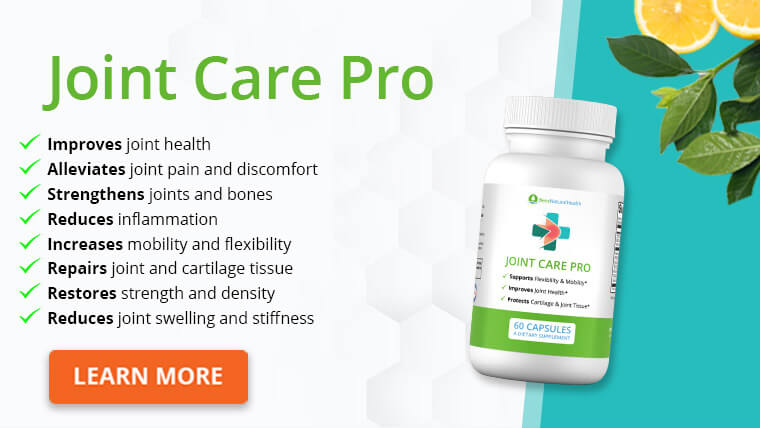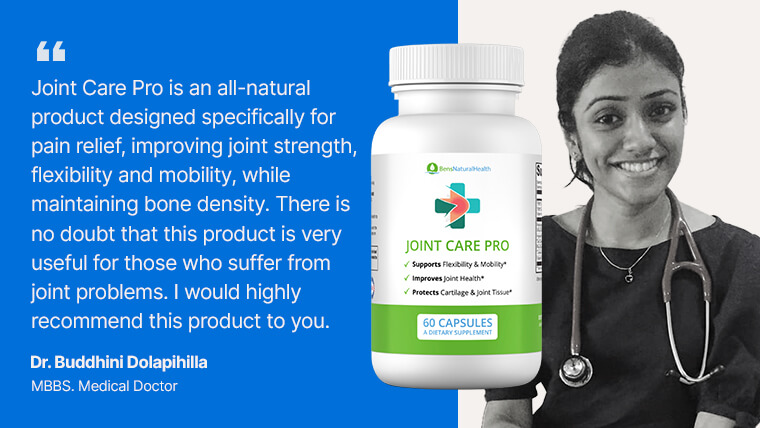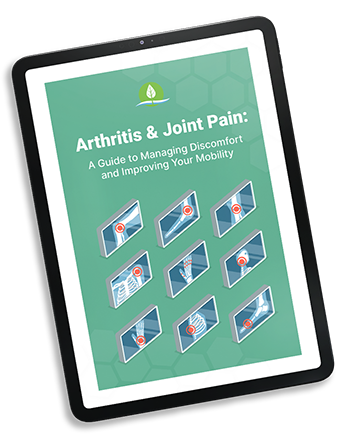Joint pain is pretty common, and it rises significantly with aging.
In the US, one-third of adults between 45 to 64 years are living with arthritis. These numbers rise to almost 50% in those 65 years or older.
Since aging is a significant risk factor for arthritis or joint pain, middle-aged and older adults should take special care of their joint health.
In addition, it is good to take lifestyle measures like dietary changes, exercise, and even the use of specific food supplements.
What is joint pain?
It is a pain in a joint likely caused by inflammation of the joint and its adjoining structures, ligaments, and tendons. Joint pain may mean aches in just any of the joints, from large joints like the knee to smaller joints like fingers. Pain in your lower back is also a type of joint pain and one of the most common chronic pain.
Joint pain may occur due to many reasons like aging, wear and tear, or autoimmune conditions, ultimately causing joint inflammation. Doctors call joint inflammatory disease arthritis. Arthritis pain is among the most common pains humans experience during their life.
However, as any disease progresses, joint deformation starts occurring due to the erosion of joint structures like cartilage. As a result, joint damage caused by inflammatory arthritis is challenging to manage. Additionally, the condition may worsen due to the overgrowth of joint bones.
This is vital to understand, as managing joint pain becomes quite challenging once the non-reversible changes in joint cartilage or adjoining bones have occurred. It also causes a compromise in joint movement.
Thus, there is a need to timely identify the joint pain and start managing its activity. Older adults should not neglect the earliest signs of joint discomfort.
Get Your FREE Arthritis Guide
- Learn how to naturally improve your arthritis symptoms
- Dietary recommendations, exercise guides, supplements, and lifestyle changes
- Developed exclusively by our medical doctor
Symptoms of joint pain
The most frequently presenting sign of joint pain is the pain on movement. Generally, this pain worsens by movement, but not always, as lots depend on the cause. For example, pain caused by autoimmune conditions is somewhat relieved by movement.
Nevertheless, the most common cause of joint pain is osteoarthritis, a condition in which pain gets worse with movement.
Since joint disorders are inflammatory conditions, joint swelling and redness are not rare. Most would also experience morning stiffness. This stiffness may last for quite a long time in some joint disorders.
Another significant symptom of joint disorders is the decreased range of motion, thus causing substantial disability in the population group.
What does joint pain feel like?
Joint pain is often felt in the knees, hips, feet, hands, or spine. In some, this pain is constant, but pain may come and go in the initial stages of joint disorders.
As the joint diseases progress, pain may become difficult to bear, causing burning or throbbing pain. This pain is associated with reduced joint movement and stiffness.
Generally, joints feel stiff in the morning, and they loosen up after 30 minutes to an hour. Mild physical activity may reduce the pain sensation, but too much physical activity may worsen the pain.
In older adults, generally, the pain of large and weight-bearing joints is more common, severely limiting the ability to carry out daily tasks. Thus, the problem is not just pain but an inability to do some everyday tasks, too.

What causes joint pain?
Joint inflammation or arthritis occurs due to many disease conditions. In addition, every joint disorder differs a bit from another and requires a different treatment approach. Thus, it is highly essential to understand various causes of joint pain.
Some of the most common causes of joint pain are:
Osteoarthritis
Osteoarthritis is the number one cause of joint pain and knee pain in older adults. It is a disease of wear and tear. Thus, it mainly affects the weight-bearing joints like knee and hip joints. However, it may also affect other joints like the ankle, wrist, hands, and lower back.
Osteoarthritis is the most common cause of knee pain, joint damage, and may cause severe pain in some.
It often affects one joint or a few joints. It is not necessarily symmetrical. This may help differentiate it from joint pain caused by systemic diseases.
Osteoarthritis primarily affects adults older than 50. Morning stiffness is another hallmark of the condition, which improves after physical activity. Loss of flexibility, swelling, and bone spurs are other signs of the disease.
The good thing about this condition is that it progresses slowly over the years. Thus, a person has time to slow down the disease progress without medications.
Rheumatoid arthritis
Rheumatoid arthritis is the second most common cause of joint pain. Most people diagnosed with the condition are 30 to 50 years old. Nevertheless, its prevalence increases with aging.
Unlike osteoarthritis, it is an autoimmune disease that causes inflammation of joints and adjoining structures like the synovial membrane. It may also affect smaller joints like those of fingers and wrist. Moreover, the condition is generally symmetrical, thus helping differentiate the condition.
Such autoimmune disorders have other associated signs and symptoms like gastrointestinal issues, anemia, fever, fatigue, and even skin rashes.
The above two conditions are the leading cause of joint disorders resulting in the vast majority of cases of joint pain. However, there are more than 100 types of arthritis. Some of the relatively more common causes could be:
Psoriasis or psoriatic arthritis
Psoriasis or psoriatic arthritis often causes joint pain that is progressive and severe, causing permanent damage to the joints. It is easy to differentiate from other causes due to typical skin rashes. However, psoriatic arthritis is quite challenging to manage.
Gout
Gout causes the accumulation of uric acid crystals, mainly in the big toe, causing severe pain and inflammation.
Injuries
Injuries may be the primary cause of arthritis and joint pain. In some, it may often lead to osteoarthritis.
Viral infections
Viral infections may cause reactive arthritis leading to painful joints. However, septic arthritis is more likely due to complications from a bacterial infection in those with weakened immunity.
Other causes of joint pain or arthritis could be systemic lupus erythematosus, ankylosing arthritis, septic arthritis, and sports injuries. In addition, some may develop constant joint pain due to repetitive actions like carpal tunnel syndrome, golfer’s or tennis elbow, and many more.
Who is more likely to experience joint pain?
Some people are more likely to experience joint pain than others. The risk factors for joint pain are both modifiable and non-modifiable. Joint pain symptoms increase with age.
Among non-modifiable risk factors for joint pain are age, gender, and genetics. Generally, women are more likely to develop osteoarthritis and rheumatoid arthritis. In addition, genetics or familial history plays a significant role in rheumatoid arthritis, lupus, and ankylosing spondylitis.
Among the preventable factors, obesity, overweight, and metabolic disorders are the leading cause of osteoarthritis and joint pain. In most cases, joint pain occurs due to wear and tear, age-related weakening of bones, slow down in anabolic processes, and mechanical damage caused to weight-bearing joints.
A relatively less common yet relevant cause of a painful joint is prolonged viral and bacterial infections causing septic arthritis or reactive arthritis.
Joint injuries caused by certain sports and occupations are other relevant causes of joint pain.
Cigarette smoking is known to increase the risk of rheumatoid arthritis, and it may also make joint pain worse in many cases.
Lyme disease is the most common vector-borne disease, affecting connective tissue and causing chronic joint pain.

When to see a doctor?
Joint pain is not a medical emergency so people are less likely to seek timely medical attention. However, prompt medical help may prevent the progress of joint disorders in many cases.
You should see a doctor if there is swelling and redness around the joint. Tenderness and redness around the joint indicate active inflammation that needs prompt care.
After trauma, you should also see a doctor, even if the pain is mild. In many instances, the severity of pain is not indicative of the damage to joints. However, more intense pain, sudden swelling, and inability to use the joint are causes for immediate concern.
Additionally, if there is a visible joint asymmetry on physical examination, it is also a cause to see a doctor.
Natural ways to relieve joint pain
One can do a few things to relieve pain and prevent the progress of joint disorder:
1. Heat and cold
Both heat and cold work for joint pain relief. However, applying cold is better during the acute phase to reduce redness, pain, and consolidation of inflammation.
On the other hand, heat is better when the condition becomes chronic. In addition, heat helps reduce joint stiffness and promotes a reduction in inflammation.
2. Weight reduction
This is a long-term strategy to prevent joint pain. It can also help provide relief from joint pain to those already experiencing joint pain.
Losing weight is one of the effective ways of causing disease remission or considerable reduction in joint pain. However, you should start weight loss efforts early enough, before the irreversible damage has occurred.
3. Exercise/physical therapy
Physical therapy is proven to help improve joint functionality. You should particularly focus on balance and flexibility exercises.
High impact exercises like running or rope jumping are contraindicated. Low impact exercises like swimming or even brisk walking can help a lot.
4. Massage/physiotherapy
These therapies help improve blood flow to joints and thus help reduce inflammation. Additionally, physiotherapy also boosts healing processes.
5. Nutrition therapy
Nutrition therapy means including specific nutrients in a diet that are good for joint health like omega-3 fatty acids, vitamin D, C, E, and K, and calcium. Consuming foods high in collagen can also help.
6. Health supplements
Supplements are excellent for preventing the progress of joint disorders. There are numerous options from various vitamins, minerals, omega-3 fatty acids, curcumin, glucosamine, and many more.
It is generally good to use a health supplement that combines multiple ingredients and then stick to it for a few months. Food supplements need time to start working.
Ben’s Joint Care Pro
Joint Care Pro, our joint health supplement, contains natural, proven ingredients that support joint care and joint health.

It is designed to improve mobility and flexibility, reduce joint pain, restore joint strength, protect cartilage and joint tissue, and rebuild strength and density.
Treatment
Joint pain is chronic, and for many, it is a condition that will last for the rest of your life. Thus, its treatment must be multidimensional, including lifestyle interventions, dietary supplements, physiotherapy, or medications.
Doctors would generally treat sudden pain with anti-inflammatory medication or non-steroidal anti-inflammatory drugs (NSAIDs). The anti-inflammatory drug suppresses pain and inflammation. However, daily use of these medications is often essential for managing arthritis, but these drugs cause stomach issues and may also increase the risk of a heart attack.
A topical pain reliever like one containing capsaicin is also good for sudden pain and joint stiffness, especially in knee arthritis.
Doctors may recommend steroids, disease-modifying antirheumatic drugs (DMARDs), monoclonal antibodies, and immunosuppressive drugs in more severe cases. However, all these medications have severe side effects on prolonged use.
Conclusion
There are many joint pain causes. Among them, osteoarthritis and rheumatoid arthritis are the most significant.
It appears that aging is the most important risk factor for joint disorders and is non-modifiable. Since one cannot prevent aging, the only way to reduce the risk of joint diseases or manage them is by strengthening the body through dietary measures, physical therapy, and nutritional supplements.
Those living with inflammatory arthritis need to know that efforts to support joint health must continue for the rest of their life. The disease remission is not the reason to discontinue taking preventive measures. Thus, health supplements that suppress inflammation and nourish joints have a special place in preventing and managing joint pain or arthritis.
Explore More







